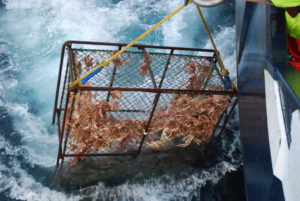Mini-symposium for Bering Sea crabbers highlights ocean acidification and warming
On May 26, members of the Bering Sea crabbing industry met with researchers to discuss the latest science on ocean acidification and climate as it relates to crab in the region. Nearly 50 people joined the conversation that was hosted by the Alaska Bering Sea Crabbers, the Bering Sea Fisheries Research Foundation, and the Alaska Ocean Acidification Network.
Some of the take homes included:
- Alaska is at risk. Alaska’s waters are expected to be impacted by ocean acidification more quickly and intensely than other parts of the globe, primarily due to cold water.
- Researchers are using models to look at ocean conditions and how they’ve fluctuated over the past 20 years. This is helpful to better understand regional scale risk and hazard exposure in the Bering Sea, especially in areas where there isn’t a lot of data. The models show conditions that are unfavorable to building shells in some places during certain times of year.
- Research on ocean acidification and crab is ongoing. The NOAA Kodiak laboratory has been conducting research on crab response to ocean acidification and warming since 2008. Results show Red king crab and Tanner crab are more sensitive to acidity than snow crab and blue king crab. Juveniles are the most sensitive to acidity while larvae appear to be resilient.
- There are a lot of differences among species and some species can adapt. The lab environment likely shows the worst case scenario for crab since there are few options for adaption (they can’t move away; switch to a different food source for energy, etc)
- Studying crab response to ocean acidification in the ocean is challenging. It is almost impossible to collect or track crab at the life stage where they are most vulnerable. There is also a large mismatch between lab-available ocean acidification information and field-available ocean acidification information.
- Models for the impact of ocean acidification on King crab could be improved with more environmental or biological information (e.g. temperature, dissolved oxygen, crab observations). This is a place where crabbers can help!
- Crab distribution and productivity have changed in the Bering Sea and much of it can be explained by environmental variables. Researchers can explain some of the changes in crab to factors such as changes in ice cover, surface temp, bottom temp, and large scale oscillations like the Arctic Oscillation). Future studies will include ocean acidification when analyzing crab dynamics.
- So far, researchers have not been able to detect changes in crab based specifically on ocean acidification, showing some resilience to current conditions. Ocean acidification and climate change and happening together and may interact in complex ways.
 Alaska crabbers expressed interest in contributing to the science looking into the affects of ocean acidification and warming on crab species, and similarly the research community is very interested in the observations, insights and engagement from crabbers. The symposium provided a launching board to foster new partnerships and approaches for researchers and crabbers to work together.
Alaska crabbers expressed interest in contributing to the science looking into the affects of ocean acidification and warming on crab species, and similarly the research community is very interested in the observations, insights and engagement from crabbers. The symposium provided a launching board to foster new partnerships and approaches for researchers and crabbers to work together.
Presentations
Introduction to OA and the Alaska Ocean Acidification Network – Darcy Dugan, Alaska Ocean Observing System (PDF)
Past, present, and future conditions in the Bering Sea – Jessica Cross (NOAA PMEL) and Darren Pilcher, University of Washington/NOAA (PDF)
Crab response to OA in the lab: Chris Long, NOAA AFSC (PDF)
Modeling wild crab response to warming/OA: Esther Kennedy, Univ. of California Davis/NOAA (PDF)
Crab management in the face of climate change: Cody Szuwalski, NOAA AFSC (PDF)

